Umweltbank (DE:UBKG) (UBK) has successfully raised additional tier 2 capital from the Green Bond Junior issue and additional subordinated debt placed to an institutional investor last year. As a result, the bank’s total capital ratio (TCR) at end-2018 reached 14.0% compared with UBK’s regulatory requirement in 2019 of 12.0%. This created a solid foundation for prospective loan book growth and we now forecast the bank’s loan book to expand at a CAGR of 7.8% over the next five years. New product launches could further support UBK’s business growth, but we believe they will also result in a temporarily higher cost income ratio (35.9% in FY19e).

Earnings likely to bottom out in FY19
UBK reported a 7.4% y-o-y decline in pre-tax profit to €37.3m in FY18 as a consequence of continued pressure on interest margin coupled with higher operating costs in conjunction with new products development and headcount increases. This has translated into a cost income ratio (CIR) of 32.7% compared with 29.4% in FY17. In our opinion, UBK’s net interest margin should reduce only slightly in FY19e and start to stabilise or even improve from FY20e. Together with healthy new lending volumes, this should translate into a gradually improving bottom line.
Solid lending activity despite a weaker wind market
UBK’s new lending volume reached an encouraging €542m in FY18, which is 26.3% ahead vs the prior year. Importantly, this was equally driven by renewable energy projects and green construction. This has continued into Q119, when UBK has granted €123.4m in loans (up 16.4% y-o-y). We particularly appreciate this in the context of the challenges the wind energy sector is currently facing. While we believe that these are unlikely to disappear in the short term, we expect UBK’s loan book to continue shifting towards sustainable building projects in FY19. Having said that, we acknowledge the strong pressure on the continued transition to a low-carbon economy, which should encourage the government to find a resolution to the wind capacity development slowdown.
Valuation: New fair value providing further upside
We have revised our valuation of UBK upwards from €11.3 to €13.0 per share, primarily on the back of raised new lending volume forecasts. Although the share price is close to our previous valuation, this still implies 13% upside potential. On our dividend expectation of €0.34, based on FY19e earnings, UBK now offers a dividend yield of 2.9% (compared to the sector average of 4.5%).
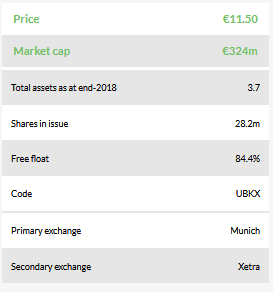
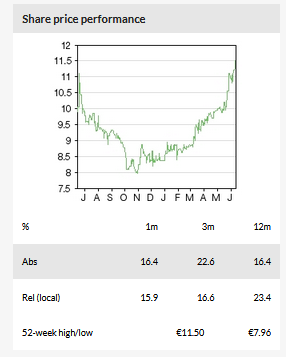
Business description
UmweltBank is a specialised lender with total assets of €3.7bn, providing financing of renewable energy projects (solar, wind, hydro and biomass), as well as loans for new construction or renovation of sustainable residential, community and commercial real estate.
Investment summary
Company description: Pure play on ‘green’ trends in Germany
UBK is a German specialist bank offering loans to customers executing renewable energy (RE) developments such as solar, wind or hydro projects (c 62.5% of loan portfolio at end-2018), as well as sustainable construction for retail, community and commercial customers (remaining 37.5%). The bank has delivered a solid 2013–18 CAGR in loans to customers as well as customer deposits at 5.9% and 6.3%, respectively. UBK’s offering also includes sustainable capital market and insurance products. Moreover, the bank holds indirect and direct equity interests in a portfolio of solar, wind and sustainable real estate projects with a value of €29.1m as at end-2018.
Valuation: Fair value of €13.0/share assisted by solid growth
We are valuing UBK using a P/BV-ROE approach, with an estimated sustainable return on tangible equity of 12.7%, a CAPM-derived cost of equity of 8.9% and a sustainable long-term growth rate of 2.0%. For the purpose of our valuation, we are treating the reserves for general banking risks created pursuant to Section 340g of the German Commercial Code as equity (see the valuation section for a detailed elaboration). Consequently, we currently arrive at a fair value of €13.0 per UBK share, implying 13% upside to the current stock price of €11.50. We have raised our valuation from €11.3 per share in our February note, which is in particular a function of our higher loan book growth expectations.
Financials: Close to an earnings inflection point
We believe that UBK’s net interest margin (NIM) is likely to gradually bottom out in FY19e (we assume a 4bp decline vs FY18), as the interest rate on the majority of its loan book is adjusted to reflect the current low-interest environment, while stronger loan book expansion (we expect a 2018–23e CAGR of 7.8%) translates into higher interest income. Amid increased investments in the development and marketing of new products, we expect UBK’s cost income ratio (CIR) to rise to 35.9% in FY19e, but gradually decline subsequently to 34.3% in FY20e and 33.4% in FY21e. Consequently, we expect pre-tax profit of €37.1m in FY19e (broadly stable vs FY18 and in line with management guidance at €37m), followed by a 9% increase in FY20e to €40.3m. We summarise our forecast revisions in Exhibit 1.

Sensitivities: Interest rates, regulations and new products
Our forecasts for UBK are dependent on a set of assumptions, including the projected path of European central Bank (ECB) rate hikes, as c 90% of UBK’s earnings before administrative costs and taxes are derived from net interest income. We estimate that every 10bp change in UBK’s net interest margin in FY18 would result in a 97bp change in the bank’s ROE (see Exhibit 10). In addition, UBK’s new lending volumes are largely driven by the regulations around renewable energy projects and sustainable construction. Finally, we treat some of the new products UBK plans to introduce as potential additional upside drivers.
Company description: Listed ‘green’ bank in Germany
UBK is the only German listed bank specialising in financing ‘green’ projects, including renewable energy (RE) sources (in particular solar and wind), as well as sustainable construction. Consequently, the bank is a play on Germany’s ongoing transition towards a low-carbon, resource-efficient economy. On top of its lending business, the bank is also active in the securities business, offering green stocks, environmental funds and green project bonds. A good example of the latter is the completion of the €7.9m bond issue of NATURSTROM confirmed in May 2019. Moreover, the bank is also involved in the distribution of green insurance products. UBK was founded in 1997 and has since provided funding to nearly 23,000 projects, and is currently serving over 113,000 clients (almost exclusively in Germany). As at end-2018, its asset base stood at c €3.7bn. UBK’s free float equals 84.4%, with the remaining 15.6% stake held by GLS Gemeinschaftsbank eG (one of UBK’s competitors) after purchasing it last year from UmweltVermögen Beteiligungs AG, an investment vehicle of UBK’s founder (Horst P. Popp) and his family.
At end 2018, UBK’s credit portfolio (excluding outstanding commitments) stood at €2.4bn and was divided into solar (37%), housing (27%), wind and hydro power (26%), as well as other projects (10%, see Exhibit 2). In comparison to 2017, the share of green construction (currently housing and social and commercial properties) has slightly increased at the expense of wind & hydro and solar power. This is in line with broader market trends, which we discuss later in the report, including bottlenecks in wind projects development, strong expansion of solar capacity and high housing demand in Germany. We estimate that UBK’s loan book has grown at a robust 2013–18 CAGR of 5.9%.
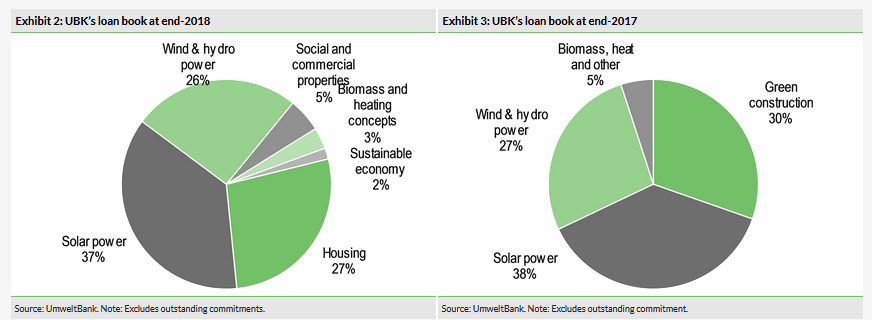
Apart from the lending business, UBK selectively acquires indirect (through its fully owned subsidiary UmweltProjekt AG) and direct equity interests in selected RE and green construction projects. As at end 2018, UBK held interests in several projects, including 48.5MW of wind park capacity, 7.1MWp of solar project capacity, 32,664sqm of residential properties and 6,324sqm of commercial space. In line with earlier intensions, UBK has expanded the equity interest portfolio to €29.1m from €22.4m at end-2016, which was particularly driven by the real estate investments, as well as solar projects. Going forward, UBK intends to acquire stakes in new solar and residential projects.
Update on the ‘3P’ strategy
As discussed in detail in our initiation note, UBK has launched several strategic actions to address key improvement areas, which include net interest margin enhancement, digitalisation, strengthening of existing client relationships and new customer acquisitions.
Firstly, UBK embarked on expanding its product range, with the initial plan to introduce a sustainable consumer credit before the end of 2018. This product would be designed to provide funding of environmentally friendly expenses of retail customers, in particular house renovation to increase energy efficiency, covering for instance heating systems, rooftop PV panels, insulation, etc (and potentially the purchase of an electric car as well). The product launch has now been delayed until end-2019. We understand that one of the reasons behind this was the need to replace the originally selected IT service provider, as the product introduction is supposed to be accompanied by the implementation of a new digital loan processing application. Once launched, we expect that the sustainable consumer loan will provide some additional relief to UBK’s net interest margin, although it will be relatively minor initially (we currently estimate a potential positive impact in FY20e and FY21e of c 1bp and 2bp, respectively).
Moreover, UBK plans to complete a bond issuance by UmweltProjekt AG (its subsidiary holding direct and indirect equity investments as mentioned above) before the end of 2019 to provide external funding and enhance its return on equity. Management has also highlighted that the bank’s team is continuously working on the development of a modern Girokonto (ie current account), which will be accessible through an online banking portal. UBK still expects it to be launched before the end of 2020. Meanwhile, the bank has successfully implemented an online customer onboarding process. It was also able to slightly expand its sustainable investment funds offering towards the end of 2018. Interestingly, UBK has accelerated the timelines of the ecological crowd-funding platform (from end 2020 to 2019) as well as the introduction of further sustainable equity funds (from 2021 to 2019). The latter include the launch of UBK’s own in-house mixed fund this year. We have conservatively not factored in the potential positive impact of these new initiatives yet, but pencilled in the additional costs associated with the new product development and marketing (see the financials section for details).
On the other hand, we do account for the potential increase in UBK’s activity in corporate fixed income securities on the back of solid customer interest. Our net commissions and fee income reflect a few small to mid-sized transactions executed per year (with the NATURSTROM bond issue being the first minor but promising development in this respect). We assume an incremental commission and fee income of c €1.0m in FY19 from the sustainable bond issue.
One of the pillars of UBK’s strategy is further team expansion, in particular with respect to credit experts, IT professionals and securities specialists. The bank’s headcount increased to 172 at end-2018 from 153 at end-2017, with the FTE equivalent at 135.9 and 118.5, respectively.
Market outlook: Solar beats wind
Germany continues its transition towards low-carbon, sustainable energy generation (the so-called ‘Energiewende’), with 6.6GW of new renewable energy (RE) capacity installed in 2018 (compared to 8.3GW in 2017, see Exhibit 4). We note that the decline in new capacity is largely attributable to wind projects, while new solar additions reached a healthy level in 2018 (as discussed below). As a consequence, total installed capacity increased to 118.3GW from 111.7GW in 2017 (see Exhibit 5) and translated into RE share in total electricity generation in 2018 of 40%. This compares with Germany’s 2030 target of 65% and 2050 target at 80%.
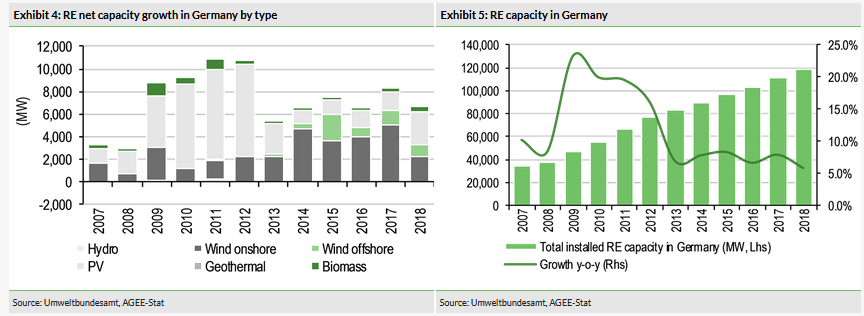
Wind power: Burdened by permit delays and local resistance
In Germany, wind capacity expansion slowed significantly, with the completion of new onshore projects representing only 2.4GW in 2018 in comparison to 5.3GW in 2017. This is only partially a function of the expansion corridor for onshore wind energy introduced with the Renewable Energy Act (EEG) 2017, as the upper limit of 2.8GW would allow for more capacity to be added. The slowdown in capacity additions continued into 2019, with Q119 seeing new onshore wind capacity at just 134MW – the lowest level since 2000. During the most recent auctions conducted in October 2018 and February 2019, only 54% and 68% of tendered capacity of 670MW and 700MW was allocated, respectively (see Exhibit 6). The lower competition for offered capacity has resulted in an increase in average allocated price to around 6.11–6.26c/kWh in the last three auctions (August 2018, October 2018 and February 2019) compared to c 3.82–5.73c/kWh during earlier tender offers.

The slowdown in wind energy development is due to bottlenecks related to extended regulatory requirements and lengthy project approval timelines (which may now take even more than two years), with local authorities being reluctant to identify new land for wind farms, which results in a deficit of approved regional plans. The German Wind Energy Association (BWE) estimates that 10GW of wind power capacity could be unlocked quickly if licensing requirements were relaxed.
The second hurdle of wind energy development in Germany is associated with the fact that projects that have already received an emission permit are often contested in court by local residents who are against the construction of new wind farms close to their households. According to CleanTechnica, over 750MW of wind farm projects got stuck in legal proceedings as of February 2019. Within the grand coalition’s acceptance/energy transition parliamentary working group, there is an ongoing discussion around increasing the residents’ acceptance through the introduction of minimum distances to residential areas, which would apply to wind turbines. This would however significantly limit the potential wind capacity expansion, with the Federal Environment Agency estimating that a minimum distance of one kilometre would reduce land available for wind farms by 20–50% and limit potential capacity from 80GW to 40–60GW, jeopardising the governmental climate targets. We agree that this would pose a considerable hurdle based on the impact of a similar regulation that was introduced in Poland back in 2016 and has imposed a minimum distance of 10 times the height of the wind turbine (the so-called ‘10H rule’). For illustration purposes, we present the net capacity additions in the Polish wind energy sector in Exhibit 7. Interestingly, the 10H rule has also been introduced in Bavaria in February 2014, effectively reducing the land available for wind farm development close to zero.
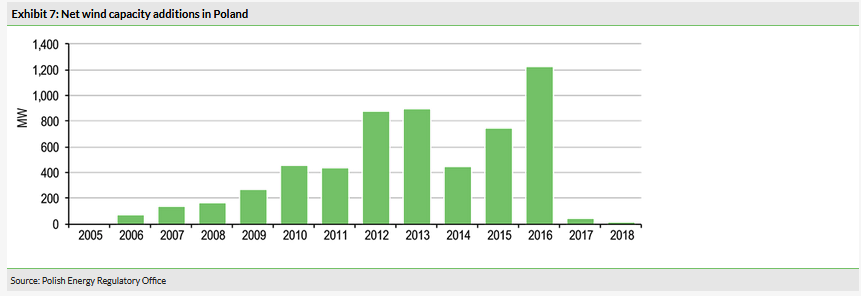
Another factor influencing the wind market negatively is the waiver of the preferential terms (ie the lack of requirement to obtain approval under the German Federal Emissions Protection Law), which until recently benefited citizen projects (Bürgerenergiegesellschaften) but has now been suspended until the June 2020 tender. These projects represented the vast majority of accepted bids during the 2017 auctions (95–99% of total allocated capacity) and also represented c 16% of the capacity allocation in the subsequent auctions.
Importantly, the slowdown in wind capacity additions coupled with increased competition globally (including in particular the expansion of Chinese players) has translated into pricing pressures in the wind turbine manufacturing industry. This has led to one of the main players (Senvion) filing for insolvency recently, although we acknowledge that there may have been some company-specific issues as well (eg high leverage). The company’s market share in Europe stood at c 11% in 2017, according to FTI Intelligence. This means that those wind projects in Germany that were supposed to be supplied by Senvion may be delayed until they have identified an alternative wind turbine provider.
On the other hand, we acknowledge the government’s efforts to stimulate further renewable energy capacity growth (in line with its 2030 target of 65% share in total electricity production), as illustrated by the recent grand coalition agreement (leading to the introduction of the so-called Energiesammelgesetz), which has set targets for additional wind and solar capacity of 4GW each over the next three years (on top of new capacity covered under EEG, see Exhibit 8). This will be allocated through special auctions organised throughout 2019–21, with 1GW offered in 2019, 1.4GW in 2020 and 1.6GW in 2021.
Moreover, the agreement covers the introduction of ‘innovation auctions’, which are technology-agnostic (ie where operators of both solar and wind projects will be able to submit bids) with 250MW capacity offered in 2019, 400MW in 2020 and 500MW in 2021. Importantly, in the case of capacity allocated during these auctions, the operator will not receive any compensation when there is excess energy supply on the market and consequently has to consider the capacity of the network when producing energy as well. This is designed as a testing environment for solutions that would encourage more competition in the sector.
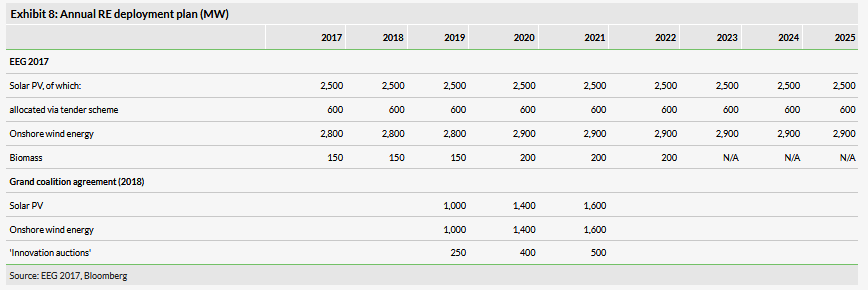
While we expect these auctions to facilitate additional solar capacity development in Germany, we are sceptical as to the positive impact of this measure on the wind energy sector, given that existing auctions are already undersubscribed and joint auctions (for both wind and solar projects where 622MW was allocated so far during three auctions since April 2018) remain completely dominated by solar projects. We believe the slow wind projects development is a function of the factors discussed above rather than an insufficient number of auctions or insufficient tendered capacity. Having said that, we believe that given Germany’s ambitious targets with respect to renewable energy generation, there is high pressure on government officials to resolve the current issues and unlock the potential of the wind energy sector.
It is also worth noting that significant progress in Germany’s renewable energy agenda will be dependent on investments in the power grid expansion. In particular, there seems to be a need for ‘power highways’, which would be used to transfer wind energy from northern to southern Germany. In this context, the introduction of a ‘south bonus’ is being considered to incentivise a more even regional distribution of new RE capacity.
Solar power: New capacity ahead of EEG targets
While the wind energy business has been struggling recently, new solar capacity reached a solid 2.94GW in 2018, which is up 77% y-o-y compared to 1.66GW completed in 2017. This was ahead of the government’s target with respect to solar capacity expansion at 2.5GW per annum. In 2019, the solar market for larger systems in excess of 750kW continues to be very strong, with the February regular auction heavily oversubscribed (465MW of submitted bids vs 178MW allocated, see Exhibit 9). Moreover, the German Federal Network Agency organised an additional 500MW auction in March, which was oversubscribed as well. Moreover, as already discussed, solar projects have taken over all the capacity during the three joint auctions conducted in April 2018, November 2018 and April 2019 (representing a total allocated capacity of 622MW vs submitted bids at 1,433MW). Despite the above, since the beginning of 2018, average prices during the regular solar auctions were steadily rising from 4.33c/kWh in February 2018 to 4.80c/kWh in February 2019, while being significantly higher during the additional March auction at 6.59c/kWh. Market prospects continue to be encouraging on the back of the recent introduction of additional capacity auctions (as discussed above). Nevertheless, we are aware that shortage of land supply may at some stage become a limiting factor.
Additional support may come from the development of projects outside of EEG within Power Purchase Agreements (PPA), ie long-term purchase agreements that may be used to refinance the construction and operation of a solar plant. This represents an interesting funding option for projects where the 20-year support within EEG is soon to expire, but also for new solar projects. UBK has recently designed a tailored product for new PPA-based projects with a maturity of up to 25 years (independent from the PPA agreement’s time horizon). The funded projects must benefit from a fixed power price set for a period of at least five years in order to be eligible for UBK’s product.

On the other hand, the market for smaller rooftop PV systems with capacity between 40kW and 750kW is likely to experience some negative impact from the recent reduction in the level of feed-in tariff (these systems are not subject to capacity auctions and still benefit from fixed compensation per kWh). This was substantiated by the regulator with the declining cost of purchasing these systems. The tariff has been reduced from 9.87c/kWh as at 1 February 2019 to 9.39c/kWh as at 1 March and 8.90 c/kWh from 1 April.
German housing market: Structural deficit persists
In the German residential real estate market, high demand combined with supply shortages continues to drive up prices (up 7.4% in 2018 across 126 German cities, according to Deutsche Bank (DE:DBKGn)), as well as average rents which were up 5% and 3.5% in 2018 for newly completed and existing homes, respectively (Deutsche Bank). Demographic expansion through immigration and the strong labour market have increased the gap between housing demand and supply, despite the number of completions improving on a yearly basis (from 188,000 in 2013 to 245,000 in 2018). Moreover, the divergence between the number of approved residential projects and the number of completed dwellings is still widening. According to DZ Bank, the key issues include a lack of designated building land, the long-winded planning permission process, speculative investments in building plots and limited spare capacity in the construction sector. As a result, approvals for residential buildings in Germany increased by just 2.0% in 2018. There is no indication that conditions will ease any time soon as building land is becoming more scarce and capacity in the construction sector has been largely exhausted. As a result, social discontent is growing, leading to more frequent and intense protests against housing policies.
This provides additional support for the affordable housing sector in Germany, which is high on UBK’s radar. Moreover, we believe that the above trends highlight the long-term potential of UBK’s green construction lending business – even if the pace of construction across Germany remains somewhat constrained in the short term. This is further driven by regulations aimed at more energy-efficient, sustainable housing such as the Energy Conservation Ordinance introduced from 2016, which requires new buildings to achieve a reduction in primary energy consumption of 25% and an improvement in building insulation of 20% versus certain reference measures defined in the regulation. We acknowledge that Germany is the European leader when it comes to introducing measures to promote energy-efficient buildings, particularly through the German development bank Kreditanstalt für Wiederaufbau (KfW), which is one of UBK’s important funding sources.
Management
UBK’s management board consists of a spokesman and two board members (all of whom are independent):
Jürgen Koppmann (spokesman) joined UBK in July 1996 in the foundation phase as a credit officer. Subsequently, he became head of the project finance department, focusing on renewable energy, heat contracting and ecological farming. Between January 2002 and the end of 2014, he was the board member responsible for credit departments. In 2015 and 2016, he left UBK to found and lead an office for the development of social housing projects. He re-joined the bank in February 2017 to lead the marketing and communication department. He was again appointed as a board member in December 2017, taking ownership of savings and investments, securities and provision, as well as IR and PR. He is also responsible for the market area of the lending business.
Stefan Weber has been with UBK since its incorporation in 1997, initially working on the introduction of an electronic data processing system. In July 1997, he became the head of operations and finance and the IT department. Mr Weber joined the management board in January 2015 with responsibility for construction finance, environmental investments, finance and IT. He also took over the risk control and credit risk functions in May 2015.
Goran Bašić started his career at UBK in the project finance department in 1999, acting as deputy head from 2008, then department head from 2011. He was appointed as a member of the management board in July 2014 and was initially responsible for the back office of the construction, solar and project finance departments. He is now overseeing the administration, HR and project finance functions. Before joining UBK, he spent two years in Sarajevo working for a consulting company headquartered in Frankfurt and setting up a bank specialising in SME lending.
Sensitivities
We have identified several sensitivities influencing UBK’s business. These include:
Green investment regulations: UBK’s new lending volumes are dependent on the state of RE sources and sustainable construction markets, in particular the regulations and support schemes affecting these sectors. Regulations governing the solar and wind energy markets are gradually changing to encourage more competition and cost effectiveness. This includes the introduction of an auction system based on feed-in tariff (FiT) premiums for solar and wind energy projects with a capacity in excess of 750kW, as well as the recent reduction in feed-in tariffs for rooftop systems with a capacity between 40kW and 750kW. Simultaneously, the wind market is currently facing bottlenecks with respect to local authority permits, as well as resistance from local inhabitants. We note that UBK has a legal due diligence process in place to address any concerns with licensing law, which also takes into account the conditions of the immediate surroundings to limit the risk that a funded project will face considerable resistance from the local community. Still, these circumstances could lead to new regulations imposing minimum distances from residential areas for wind turbines, which may depress new installed capacity. Moreover, there is a risk that tendered capacity limits could lead to more aggressive bidding by developers and result in a premium squeeze, lowering the cash flow generation potential of the projects. Given the high leverage of commercial projects (often around 75% of total investment value), this may lead to higher default rates in the sector and an increase in UBK’s non-performing loans (NPL) ratio. Having said that, the recently raised new capacity targets, as well as low allocations in current wind auctions suggest this risk will not materialise in the near term. Moreover, from UBK’s perspective it is important to note that a lending commitment is made after the premium has been allocated to the developer following the auction, which increases cash flow visibility and reduces credit risk. Nevertheless, the new system will result in banks performing more complex project evaluation before making a decision on lending, which may actually enhance UBK’s competitive edge, given its specialisation in financing RE projects. In the wind energy segment in particular, it is possible that a combination of caps on new installations (below net additions from recent years) and increased difficulty of project assessment may discourage some of the other banks from funding wind projects, as they prove to be too small (for large banks) or too demanding from an evaluation perspective (for smaller players).
Changes in market interest rates: as with any other bank, UBK’s profits are sensitive to the level of market interest rates in the euro area, which have remained at record-low levels for a prolonged period of time. This resulted in a decline in UBK’s net interest margin after 2015. However, as discussed later in this note, we believe the margin should soon start to bottom out. Still, a continuation of the ECB’s current policy may further limit UBK’s profitability, while interest rate normalisation should assist its results. In anticipation of prospective interest rate hikes, UBK has already been reducing the average fixed interest rate period on its assets to maximize the benefits from a potential recovery in market rates. However, it must be noted that interest rate hikes may also result in lower loan availability and higher borrower default rates. This is particularly important given the investment community’s strong interest in RE projects over the past few years. Moreover, given that the interest rate on the majority of loans to customers is fixed for 10 years, a very sharp short-term increase in market interest rates may have a negative impact on UBK’s net interest margin. Below we include a sensitivity analysis showing how our FY19 forecasts would look at different net interest margin levels.

Funding risk: UBK’s competitive edge is partially based on the ability to offer attractive lending terms to its customers, which is possible, among other things, due to access to preferential funding from KfW and other public development banks. A reduction (or expansion) of available funding may hamper (or assist) UBK’s credit portfolio growth. Also, it is worth highlighting that UBK’s liabilities to banks as at end 2018 included a €200m TLTRO-II facility, which was provided by the German central bank in 2016 and matures after four years. The final terms of TLTRO-III (more details to be shared by ECB in September 2019, first tranche likely in 2019) will be one of the factors determining UBK’s funding structure and interest margin.
Success of new products: we have so far only included the launch of UBK’s sustainable consumer credit in 2019, thus leaving some upside potential to our valuation from the introduction of further products. Our current forecasts exclude incremental earnings from several products to be launched by UBK over the next few years, such as current accounts, the ecological crowd-funding platforms, as well as new sustainable investment funds. Also, the expansion of UmweltProjekt AG’s equity participation portfolio (€29.1m as at end 2018) may prove stronger and more profitable than we currently expect.
Digitalisation and recruitment: the pace of UBK’s digital technology adoption and team expansion will determine the success of the new product launch. Moreover, the relationship between overall implementation costs and incremental income will have a significant impact on UBK’s cost-income ratio.
Risk of reputational damage: UBK positions itself as a truly green, transparent and ethical bank. Any failure to comply with its funding eligibility criteria or to provide appropriate information to customers about the investment and insurance products offered to them may have a significant negative impact on UBK’s reputation and, as a result, reduce available customer deposits.
Ongoing litigation over a licence agreement: in October 2017, UBK announced that it was in a legal dispute with DUT UmweltTreuhand related to licence payments that, according to UBK, were made by the bank based on an ineffective contract signed in 1995. A positive litigation outcome may translate into an additional one-off cash inflow of c €4.0m (or €0.14 per share). However, there is no visibility on the likelihood or timing of the potential dispute win.
Valuation
We value UBK using an implied price to tangible book value method based on our estimate of the bank’s sustainable ROE and cost of equity derived from the Capital Asset Pricing Model (CAPM). This is a common valuation method for banks, which allows us to reflect UBK’s specific profitability as well as risk profile. To arrive at the book value of UBK’s tangible equity, we have subtracted the balance sheet value of intangibles from our shareholders’ equity forecast. We calculate the return on tangible equity using net profit after tax, but before allocation of reserves pursuant to Section 340g of the German Commercial Code (reserves for general banking risks). These allocations are subject to income tax and the corresponding reserves form part of UBK’s CET1 capital. Furthermore, the bank only needs to create reserves at a level equal to 10% of income from its trading book generated during the year, which in UBK’s case is normally close to zero. Hence, we believe these allocations should not reduce net profit for valuation purposes. Simultaneously, we have added the balance sheet amount of these reserves to tangible equity.
We forecast UBK’s tangible book value per share at €8.7 at end 2019, compared with €8.2 at end 2018. This represents a c 7% y-o-y increase, which is a function of net profit before allocation to reserves of €25.4m (broadly in line with FY18), an earnings retention rate at 54% of net profit after allocation to reserves and the assumption that c 50% of UBK’s dividend will be paid in shares rather than cash (broadly in line with actual proportions in 2018). We estimate UBK’s sustainable return on tangible equity (after tax but before allocation to reserves) at 12.7%. This return ratio has been adjusted for the proportion of equity capital on UBK’s balance sheet, which is beyond the level needed for UBK to meet its regulatory requirements and secure further business growth (we assumed that CET1 of 9.0% should be sufficient and treated all the remaining equity as excess capital). We have factored in a cost of equity at 8.9% and a long-term growth rate of 2.0%. Based on these assumptions, we have arrived at a fair value per UBK share of €13.0 (see Exhibit 11) compared to our previous valuation of €11.3.
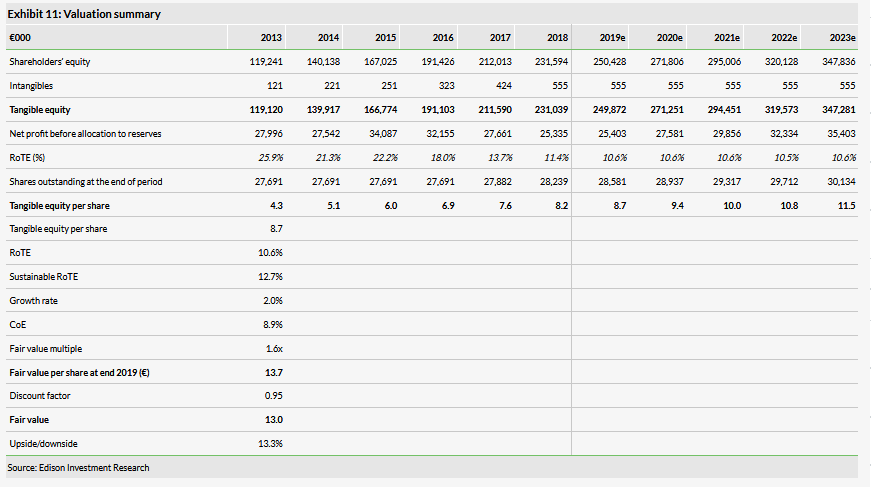
Below we also include UBK’s valuation sensitivity analysis based on cost of equity and sustainable return on tangible equity.

Due to the lack of similar listed sustainable banks that would represent UBK’s close peers, we have combined a set of large and smaller banks from the DACH (Germany, Austria and Switzerland) region. As illustrated in Exhibit 13, UBK is currently trading broadly in line with the market in terms of the ratio of return on equity (ROE FY19e of 10.6%) to its book value multiple (P/BV FY19e of 1.3x). However, we believe the FY19 results are likely to represent a trough in UBK’s return on equity.